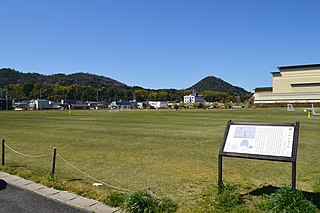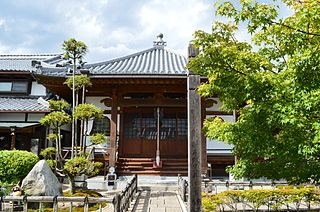Hinodeyama Tile Kiln ruins is an archaeological site consisting of the remains of seven Nara period kilns located in what is now the town of Shikama, Miyagi Prefecture in the Tōhoku region of northern Japan. It has been protected by the central government as a National Historic Site since 1976.

The Akahogi Tile Kiln site is the remains of a late Nara period, early Heian period roof tile and pottery production site located in the Akahogi neighborhood of the city of Takayama, Gifu Prefecture in the Chūbu region of Japan. It has been protected as a National Historic Site since 1976.

The Irago Tōdai-ji Tile Kiln ruins is an archaeological site containing the remnants of a number of Anagama kilns, from which the roof tiles for the Kamakura period reconstruction of the temple of Tōdai-ji in Nara were made. The site is located in the Irago neighborhood of the city of Tahara, Aichi Prefecture in the Tōkai region of Japan. It was designated a National Historic Site of Japan in 1967.

The Otomefudōhara Tile Kiln ruins is an archaeological site with the ruins of an early Nara period kiln, located in the city of Oyama, Tochigi Prefecture in the northern Kantō region of Japan. It was designated a National Historic Site of Japan in 1978.
The Yūki temple ruins is an archaeological site with the ruins of a large Buddhist temple located in the Yabata-Kamiyamakawa neighborhood of the city of Yūki, Ibaraki, in the northern Kantō region of Japan. The temple no longer exists, but the temple grounds were designated as a National Historic Site in 2002.

The Kawaratsuka kiln ruins is an archaeological site with the ruins of a Nara to Heian period factory for the production of earthenware, located in what is now the city of Ishioka in Ibaraki Prefecture in the northern Kantō region of Japan. It received protection as a National Historic Site in 2017.

The Shimōsa Kokubun-ji (下総国分寺) is a Buddhist temple located in the city of Ichikawa, Chiba, Japan, belonging to the Shingon-shu Buzan-ha sect. The present temple is of uncertain foundation, but claims to be the direct descendant of the original Nara period provincial temple ("kokubunji") of former Shimōsa Province. which fell into ruins sometime during the Kamakura period. The Nara-period temple ruins were designated a National Historic Site in 1967, and the area under protection includes the site of a kiln used to produce roof tiles used by the temple. The area designated was expanded in 2002

The Suedono Tile Kiln ruins is an archaeological site with the ruins of a Kamakura period kiln, located in the Numagami neighborhood of the city of Misato, Saitama Prefecture in the Kantō region of Japan. It was designated a National Historic Site of Japan in 1931.

The Ōya Tile Kiln ruins is an archaeological site with the ruins of a Hakuho period kiln, located in the Ōya neighborhood of the city of Higashimatsuyama, Saitama Prefecture in the Kantō region of Japan. It was designated a National Historic Site of Japan in 1931.

The Shindō temple ruins with Oganji-ike tile kiln ruins, is an archaeological site with the ruins of a Hakuhō period Buddhist temple and roof tile kiln remnants located in the Midorigaoka-cho and Nakano-cho neighborhoods of the city of Tondabayashi, Osaka, Japan. The temple and kilns no longer exists, but the loctations were collectively designated as a National Historic Site in 2002 together with the Okameishi Kofun.

Hie temple ruins is an archeological site with the ruins of a Hakuhō period Buddhist temple located in the Hie neighborhood of what is now the city of Nankoku, Kōchi, Japan. The foundations of its pagoda were designated as a National Historic Site in 1934, with the area under protection extended in 1982.
Fuchū-Yamanouchi Tile Kiln ruins is an archaeological site consisting of the remains of a Nara period kiln located in what is now the Fuchu neighborhood of the city of Sakaide and the Kokubunji neighborhood of the city of Takamatsu, Kagawa Prefecture on the island of Shikoku, Japan. It has been protected by the central government as a National Historic Site since 1922.

Ōmidō temple ruins is an archeological site with the ruins of a Nara period Buddhist temple located in the Daikyōji- neighborhood of the city of Kurayoshi, Tottori prefecture, in the San'in region of Japan. It was designated as a National Historic Site in 2001.

The Mantomi Tōdai-ji Tile Kiln ruins is an archaeological site containing the remnants of a number of anagama kilns, from which the roof tiles for the Kamakura period reconstruction of the temple of Tōdai-ji in Nara were made. The site is located in the Seto neighborhood in Higashi-ku in the city of ,Okayama, Okayama Prefecture in the San'yō region of Japan. It was designated a National Historic Site of Japan in 1927, with the area under protection expanded in 2004.
The Ōyamazaki Tile Kiln ruins is an archaeological site with the ruins of an early Heian period kiln, located in the town of Ōyamazaki, Otokuni District, Kyoto Prefecture in the Kinai region of Japan. It was designated a National Historic Site of Japan in 2006.
The Hayaagari Tile Kiln ruins is an archaeological site with the ruins of a Nara period kiln, located in the Udo neighborhood of the city of Uji, Kyoto Prefecture in the Kinai region of Japan. It was designated a National Historic Site of Japan in 1986.
The Tomoeda Tile Kiln ruins is an archaeological site with the ruins of a Nara period kiln, located in the town of Kōge, Chikujō District, Fukuoka Prefecture Japan. It was designated a National Historic Site of Japan in 1922.

The Funasako Kiln ruins' is an archaeological site containing a Nara period kiln located in the Funasako neighborhood of the town of Chikujō, Chikujō District, Fukuoka Prefecture Japan. The site was designated a National Historic Site of Japan in 1999.

Chikuzen Kokubun-ji (筑前国分寺) is a Shingon-sect Buddhist temple in the Kokubunji neighborhood of the city of Dazaifu, Fukuoka, Japan. It is one of the few surviving provincial temples established by Emperor Shōmu during the Nara period. Due to this connection, the foundation stones of the Nara period temple overlapping the present day complex were designated as a National Historic Site in 1922.

The Ōsumi Kokubun-ji (大隅国分寺) was a Buddhist temple located in what is now the Kokubu neighborhood of the city of Kirishima, Kagoshima, Japan. It was one of the provincial temples per the system established by Emperor Shōmu during the Nara period for the purpose of promoting Buddhism as the national religion of Japan and standardising Yamato rule over the provinces. The temple no longer exists, but the temple grounds were designated as a National Historic Site in 1921. In May 2004, the Miyatagaoka Tile Kiln Ruins was added to the National Historic Site designation.

















